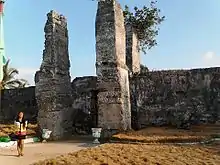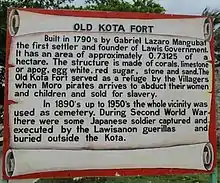Presidio de Lawis
Presidio de Lawis, known more commonly as the Kota or fort,[1][2] was a Spanish fortification laid-down around 1628-1630[3] in the northernmost tip of Bantayan Island in Central Philippines by the Cebuano Spanish Army that became the nucleus of the modern-day municipalities of Madridejos, Bantayan, and Santa Fe in the Philippines.


The edifice is the Philippines's oldest surviving, and longest standing original Spanish military fort, older than Fort San Pedro (built in 1739), Fort Pilar (rebuilt 1666 ; reconstructed 1718),[4] Fort San Felipe in Cavite (partly abolished during the US regime to giveway for the construction of a Naval Station, and completely destroyed during World War II), Fort San Pedro (Iloilo) pulverized during World War II, and Fort Santiago in Manila (the current structure is only a replica, the original Spanish structure was totally destroyed during WWII).
History
The contradicting claims between the town's centuries old Oral Tradition that states the fort's foundation in Madridejos, Cebu can be traced back to the time of Lapulapu's grandson who was the builder of the Kota itself, and the conclusion made by some modern researchers that claims the fort was only built in 1790s
that again another research was initiated and conducted by Eng'r Brient Mangubat, and Eng'r Josito Clamor Dondon whose roots both came from Bantayan, in an effort to look for contemporary accounts , historical records that could be used to support or consistent to the town's Oral Tradition or word of mouth.
And it was found that there was indeed a fort constructed in Bantayan Island more than a hundred and sixty years ago before the year 1790s came
after the Pirates raid in year 1628, an indio ( a term used to denote a filipino native) initiated the fort's construction . according to the accounts of Fr. Juan de Medina in year 1630
and in year 1750 the existence of a fort in Bantayan Island was again mentioned, debunking therefore the conclusion that Bantayan Island started to have a fort only in the 1790s or in later years specially in the 1800s.
References
- Lavilles, Gervasio L. (1965). History: Cebu's 4 cities & 49 municipalities with trimmed accounts of Christianization of the Philippines. Lavilles. p. 92. Retrieved 1 March 2020.
- "Madridejos wants to fix landmark". Sunstar Cebu News. Retrieved 29 February 2020.
- "Chapter 7: Promoting Philippine Culture and Values" (PDF). List of Priority Programs and Projects in the 2017-2022 Public Investment Programs (PIP)*. National Economic and Development Authority Philippines. p. 2. Retrieved 28 February 2020.
- Orendain, Antonio (1984). Zamboanga hermosa: memories of the old town. Zamboanga City (Philippines): Filipinas Foundation, 1984. pp. 66, 254. Retrieved 10 February 2020.